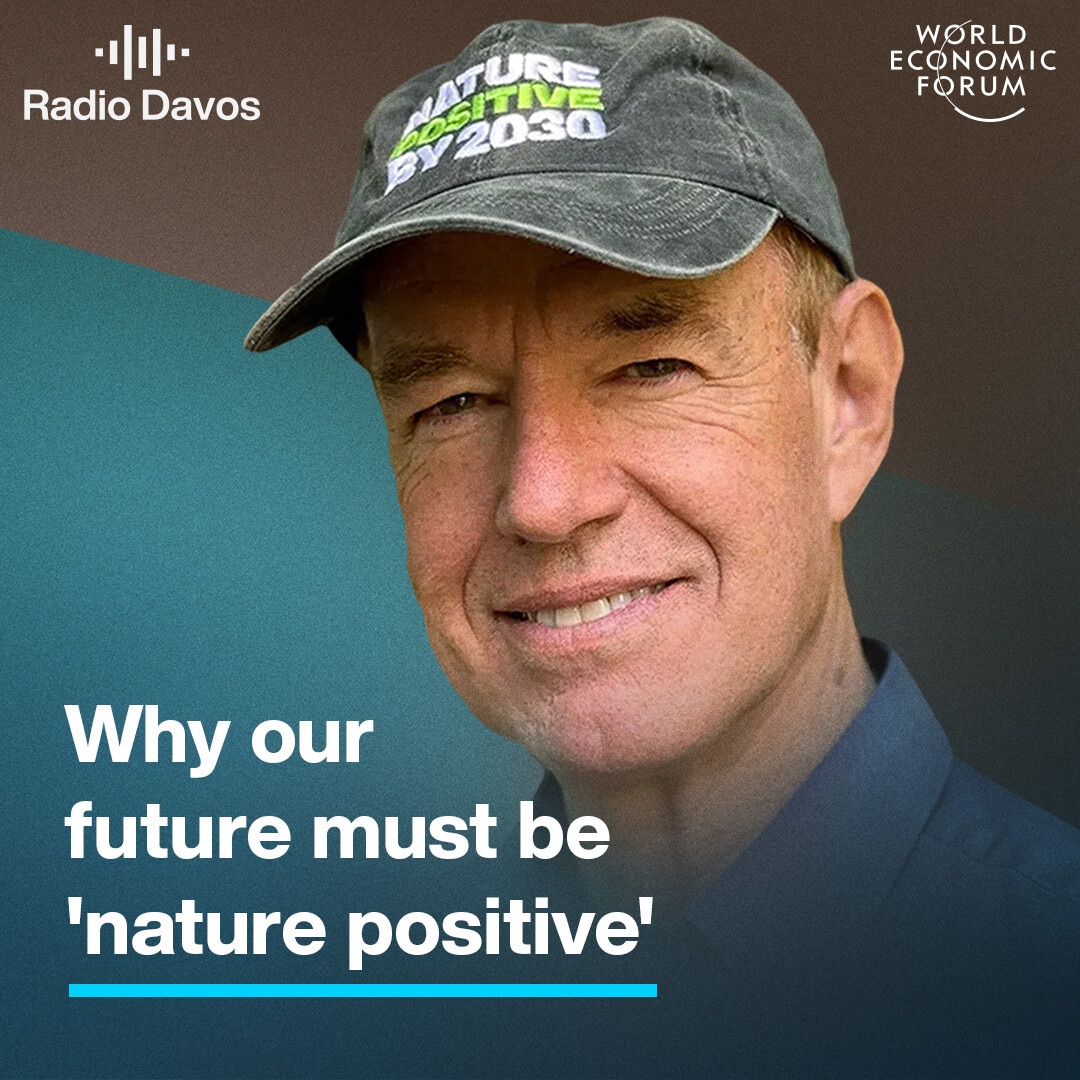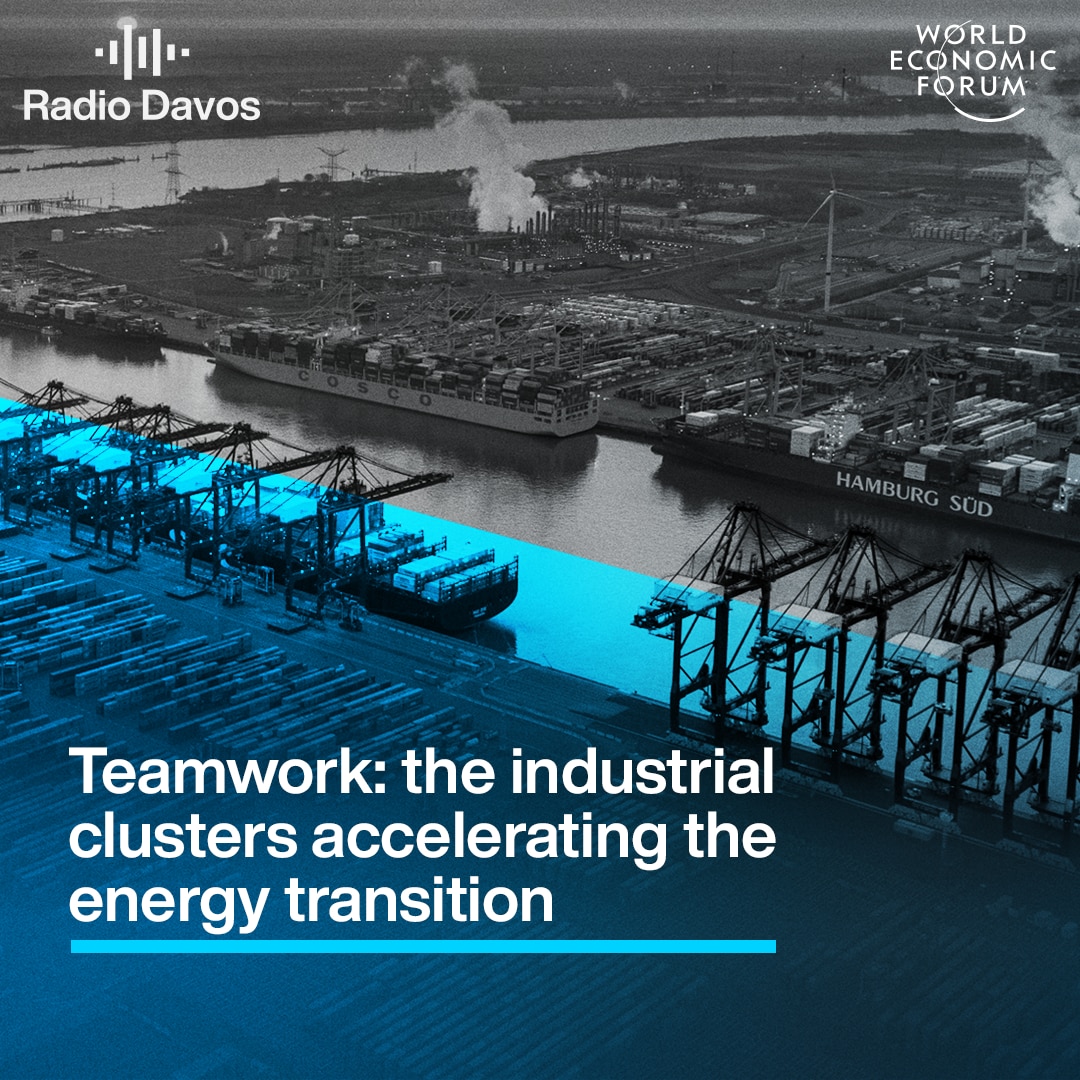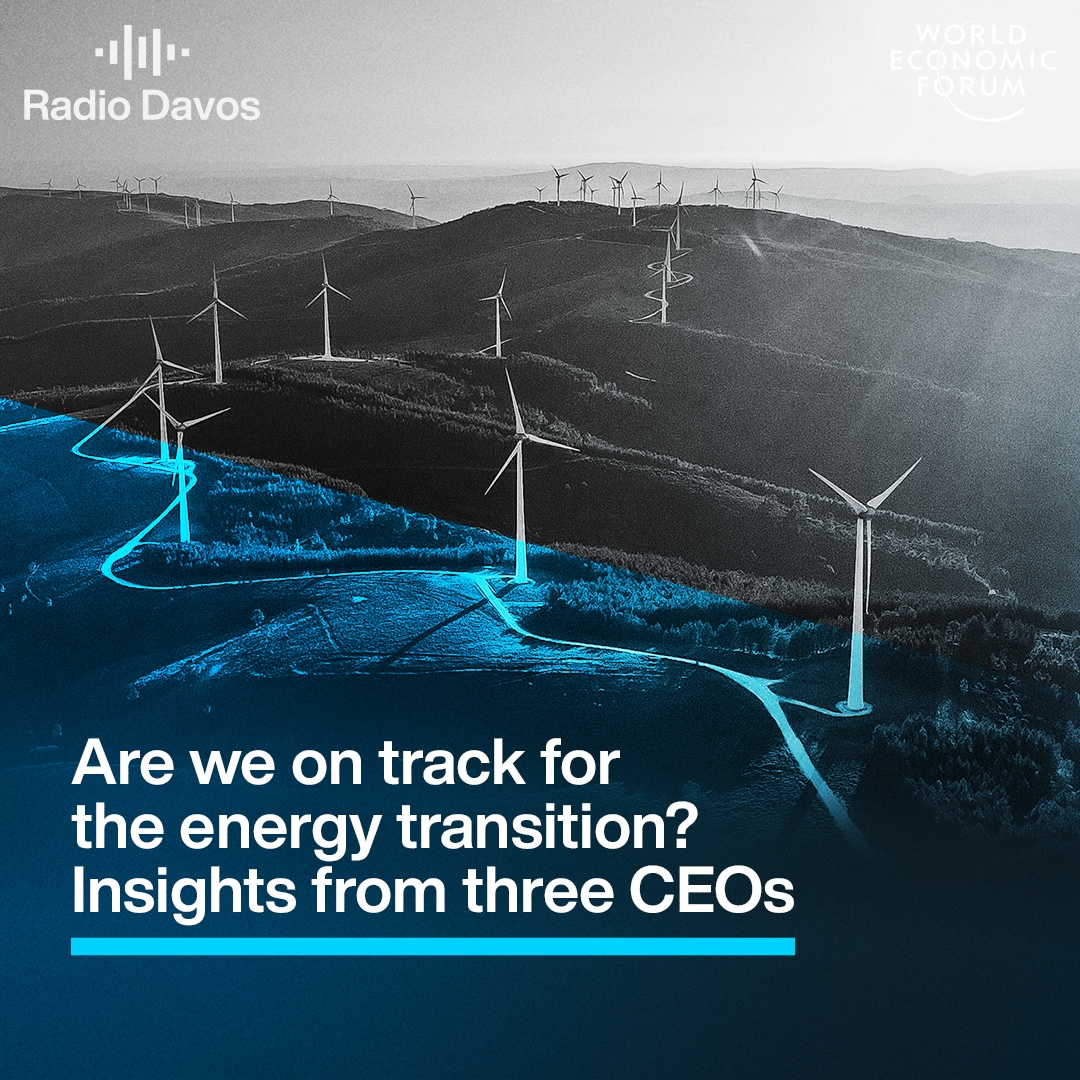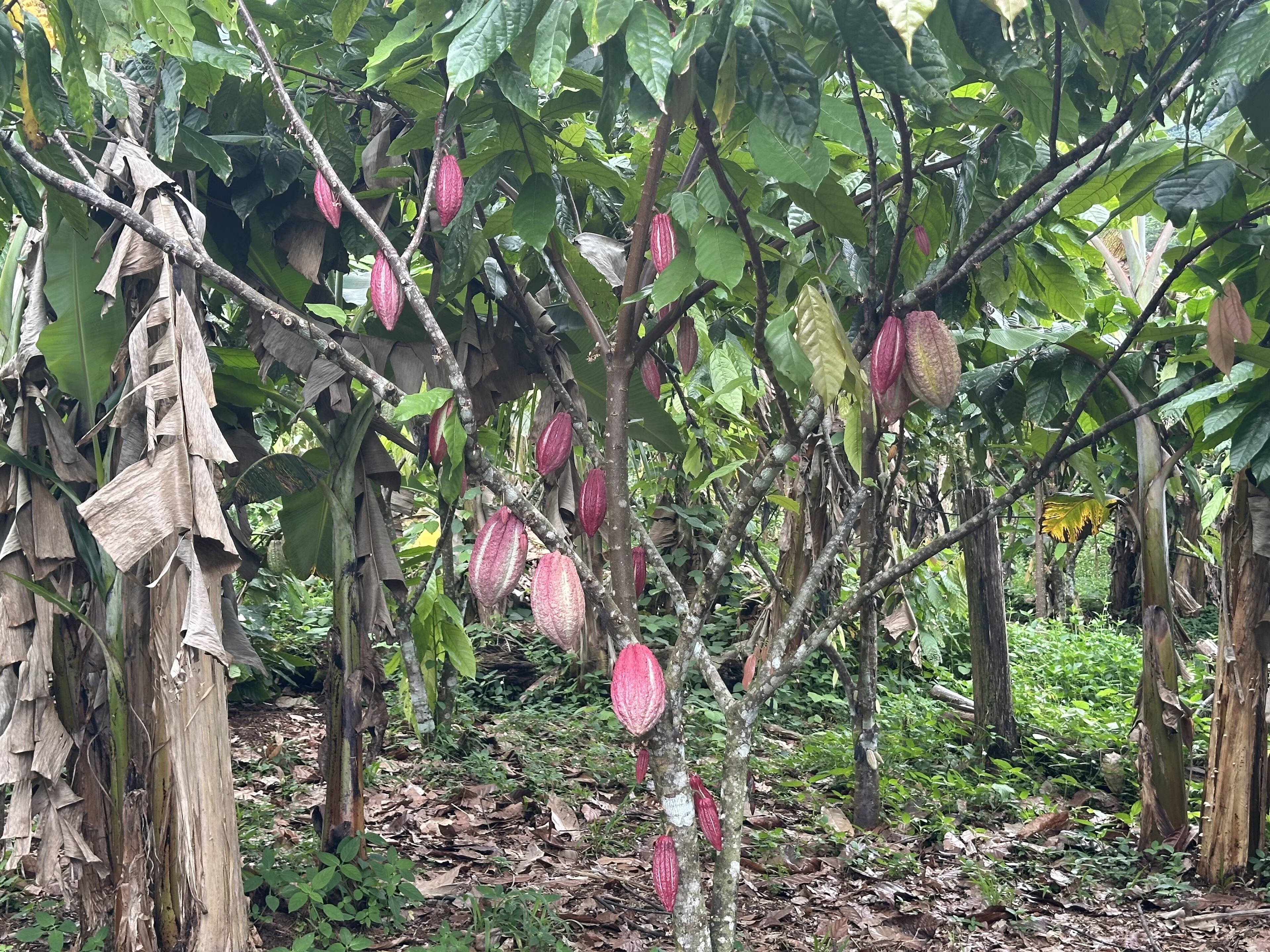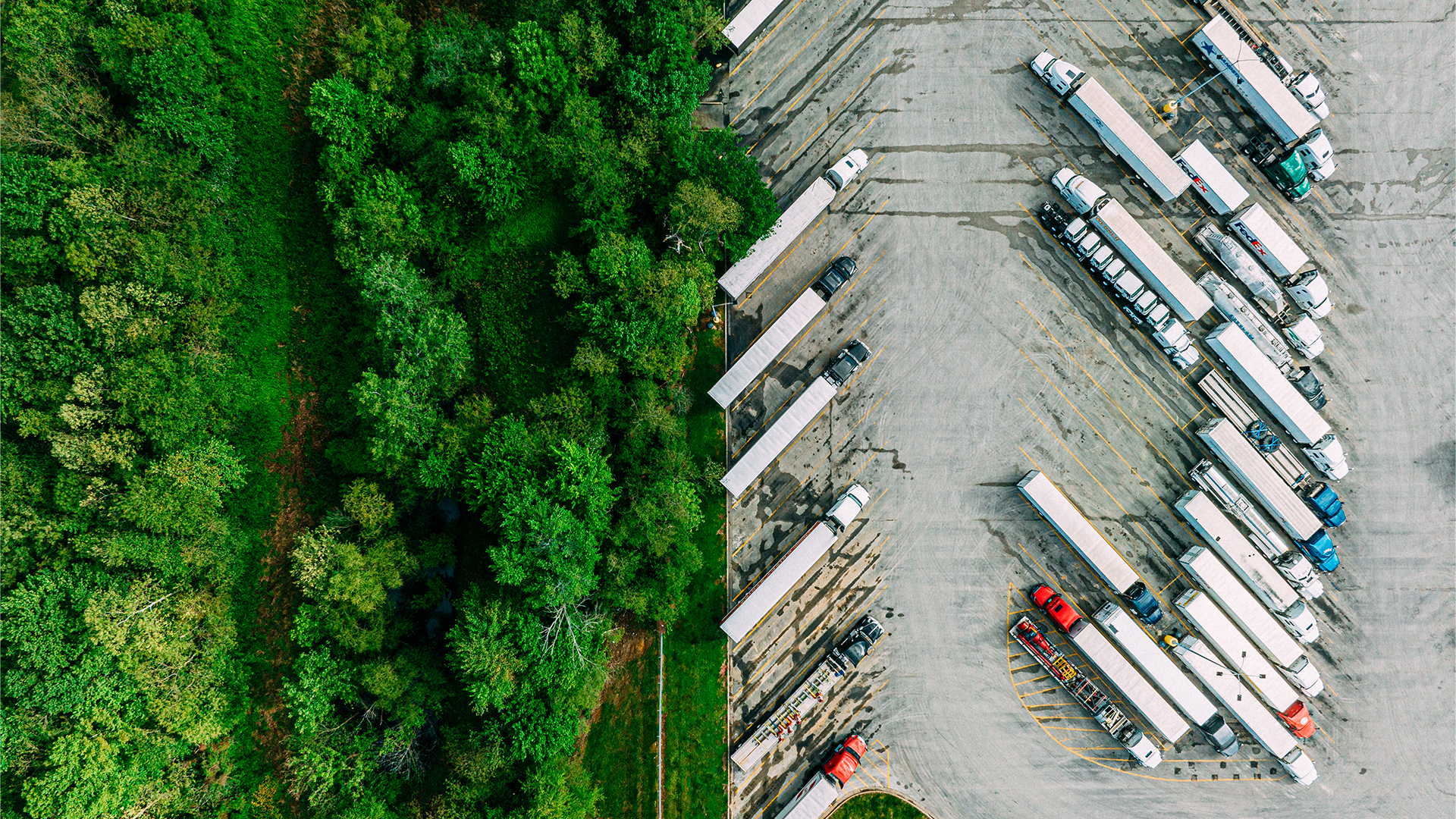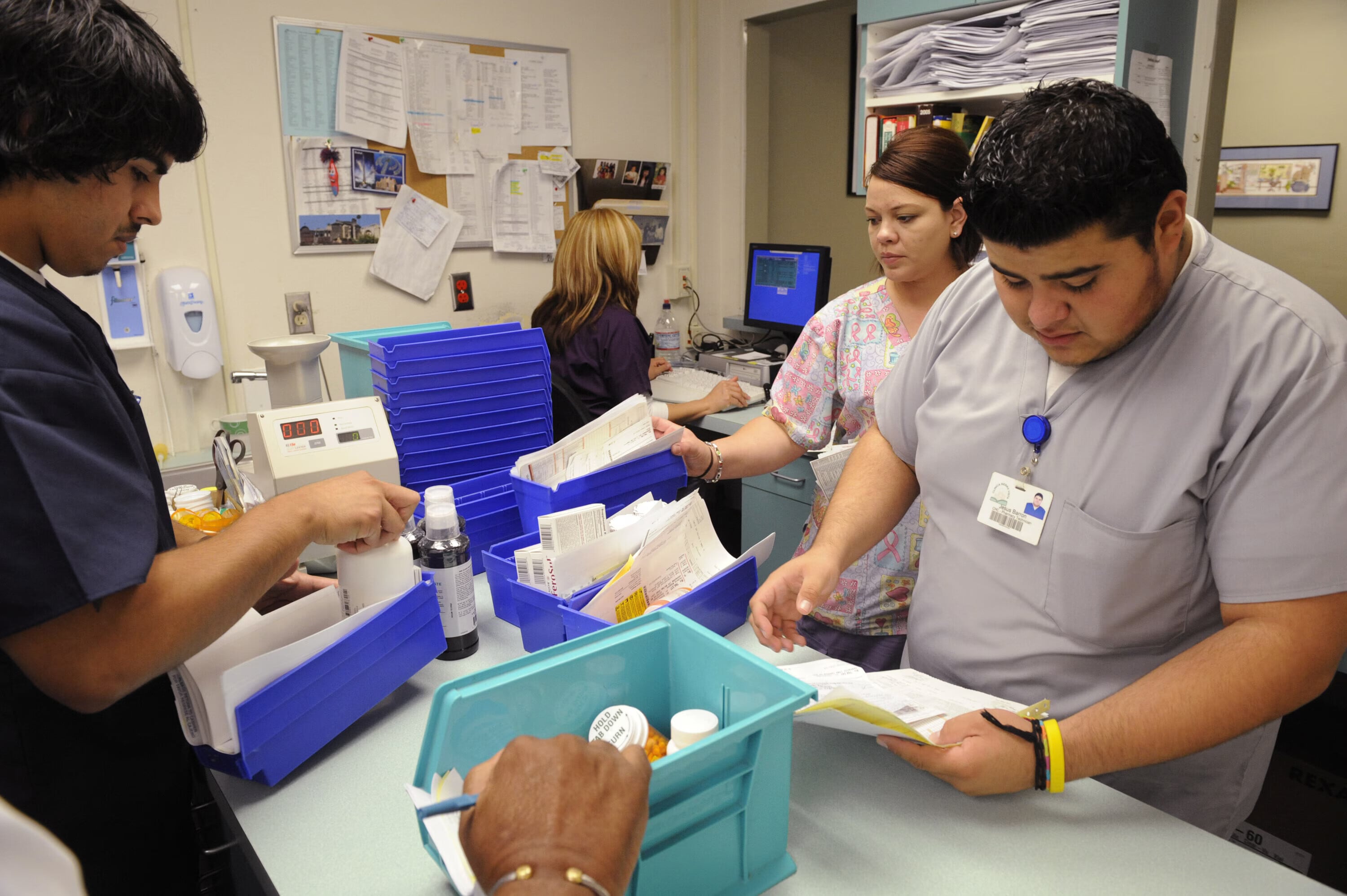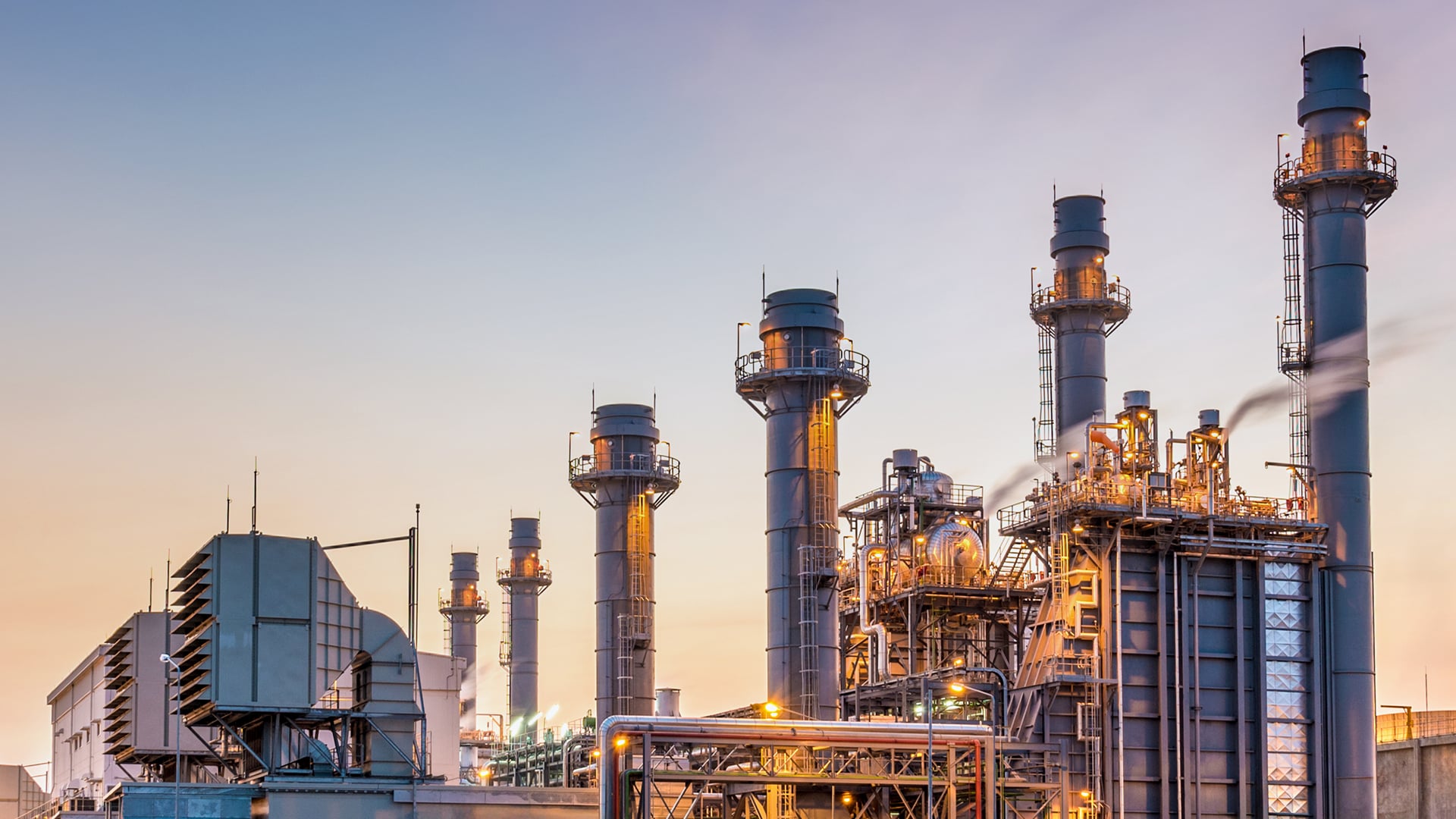Can aviation ever be sustainable? Here are some paths to net zero
Scroll down for full podcast transcript - click the ‘Show more’ arrow
Aviation is growing, but its environmental impact does not have to - if the technology and policies are available to de-carbonise the sector.
We hear from a company making sustainable aviation fuel with waste CO2; the head of one of the world's busiest airports, and from the body representing airports around the world.
Related podcasts:
Guests:
ポッドキャスト・トランスクリプト
This transcript has been generated using speech recognition software and may contain errors. Please check its accuracy against the audio.
Laia Barbarà, Head, Climate Strategy - Net Zero, World Economic Forum: Aviation is one of the greatest humankind inventions. However, our most important journey just yet is to decarbonize the sector.
Robin Pomeroy, host, Radio Davos: Welcome to Radio Davos, the podcast from the World Economic Forum that looks at the biggest challenges and how we might solve them. This week can air travel ever be environmentally sustainable?
Justin Erbacci, Director General, Airports Council International World: To have aviation become more sustainable is a very complex topic. Nobody in the industry can wave a magic wand or work very hard and accomplish carbon neutrality or sustainability by themselves. They really need to have everybody in the industry working collaboratively.
Robin Pomeroy: We hear about the technologies that could decarbonise aviation.
Paul Griffiths, CEO, Dubai Airports: One of the ways forward is clearly sustainable aviation fuel. At the moment, however, this only accounts for 0.7% of the total fuel production. That means that the entire SAF production would be consumed in 50 hours during the course of a whole year.
Robin Pomeroy: We speak to a company that is making jet fuel using carbon dioxide emitted by industry.
Ayesha Choudhury, Chief Commercial Officer, Infinium: You're taking that CO2 from a steel mill, from an ethanol plant, from a pulp and paper, from oil refining. We're capturing that and we're using that as our feedstock
Robin Pomeroy: Follow Radio Davos wherever you get your podcasts, or visit wef.ch/podcasts where you will also find our sister programmes, Meet the Leader and Agenda Dialogues.
I’m Robin Pomeroy at the World Economic Forum, and with this look at how we make aviation sustainable…
This is Radio Davos
Robin Pomeroy: Welcome to Radio Davos. And this week we're talking about sustainable aviation. And later in the program we'll be hearing from the person who runs one of the world's busiest airports, from a company that makes aviation fuel by using carbon captured from industry, and from the head of the global airport organisation, the Airports Council International.
And to co-host this episode on sustainable aviation, joining me is Laia Barbarà. Hi,Laia. How are you?
Laia Barbarà: Hello, Robin. Happy to be here with you.
Robin Pomeroy: Tell us what you do at the World Economic Forum.
Laia Barbarà: So, Robin here, I head the climate strategy team, which includes the sustainable mobility work that we do, including in particular the aviation de-carb portfolio that we're going to be talking about today.
Robin Pomeroy: And you were telling me before, you've got a background in aviation.
Laia Barbarà: Yes. I'm not only an aviation geek, but also an aerospace engineer by background..
Robin Pomeroy: Perfect. So but you cover a lot of industries, though, in your brief. So give us an idea of why aviation is important when it comes to global carbon emissions and, you know, the energy transition and all that.
Laia Barbarà: So aviation is one of the greatest humankind inventions, right? It allows the economy to grow. It allows families to get together, cultures to be exposed to others. And businesses are being made through meetings of people travelling by air oftentimes.
However, our most important journey just yet is to decarbonize the sector.
And if we look back, we can see that the transition from coal to oil to gas took us around 60 years. And the bad news is that we cannot afford another 60 years to decarbonize the aviation sector now.
So we get to look at what are the low hanging fruits while we develop the more permanent solutions.
Robin Pomeroy: As we'll hear in those three interviews that I mentioned earlier, there are actually lots of ways to approach decarbonising aviation or making aviation sustainable. I mean, what would you say are the most important or the most interesting ones?
Laia Barbarà: If you allow me, I'll start by sizing the problem that we're trying to tackle here.
So on one side, sustainable aviation just five years ago was an oxymoron pretty much for everyone. And today we already have solutions deployed at scale. So that's that's already a good a good start.
And then on the other side, if we look at the air traffic growth, we know that it is projected to double by 2042. And just to give you an indication and how it looks like, the forecasted traffic this year, it's expected to exceed the 12 billion passengers. So that's what we're talking about.
And then you were asking me what are the solutions? Well, now that we know the challenge, I think that the solutions, first of all, starts by understanding that the problem is not flying. The problem is CO2. So how can we tackle the CO2? How can we decouple it from this growth that is projected while we continue flying and exploring this beautiful world.
So we have short-term solutions and long-term ones, and we have we got to do a bit of a choreography to balance them and change from one to the other.
What is available today? Today you can fly on certain percentages of sustainable aviation fuels. You may have heard of SAFs. That's how we refer to them.
Robin Pomeroy: Yes. And in fact, we're going to hear quite a few acronyms from these. SAF is the one that keeps coming up, sustainable aviation fuels. You'll probably mention a couple of others now.
Laia Barbarà: Exactly. So SAF today. But it's it's not the perfect solution just yet because we need more SAF and better quality SAF. But it's available today and that's something very important to have to flag.
Then we have what we call destination technologies, the true zero technologies. And those are basically categorised in two big buckets. One, electric aviation. We know that it is possible. We know that hopefully within the next decade we will have some examples in place. But shorter range, less autonomy, less passengers, probably so not fit for purpose for every single type of travel.
Robin Pomeroy: Like battery-operated planes.
Laia Barbarà: Exactly. And then on the other side, the hydrogen sister solution. And this is two-fold: hydrogen fuel cells or hydrogen-fuelled aircrafts. And then those may allow you to have greater autonomy, bigger distances, greater ranges, but probably will penetrate the market just a bit later on.
Robin Pomeroy: Now, the reason we making this episode right now is because you produced this paper called the Global Aviation Sustainability Outlook. Tell us what that is.
Laia Barbarà: So we just learned during Aviation Day in our headquarters here in Geneva, this 2025, our flagship sustainable aviation report that basically tells CEOs how to go about it.
So the issue is as follows. There are many solutions. Not of them are available now. However, CEOs and big decision makers need to make investments today that will lock them up into a particular solution for the next decade, if not longer, right? Depending on the type of assets they're investing in. So we want to help them. We want to shed some light into what are no regrets moves, while we also give a snapshot of where is the sector today when it comes to their companies. And, b, what are the main risks that CEOs perceive? So after having interviewed more than 40 CEOs from the industry, we know I can reveal to you and please, I encourage you to go read the paper as well, that one of the biggest top of mind problems risks that a CEO see is the lack of feedstock availability and the cost of this feedstock to create the so-called SAF, sustainable aviation fuel.
Robin Pomeroy: There's this kind of a chicken and egg problem, isn't there, that an airline might want to buy this fuel, sustainable aviation fuel, but it's not being produced in enough quantities and at a cost that is really affordable. But then the companies making that need to know there's a market there. I suppose that's maybe where the World Economic Forum comes in, because it brings together, famously, the stakeholders of one end and the other, as well as regulators and governments.
Laia Barbarà: Exactly. So we're trying to break the eggs and make a tortilla, if that, if that makes sense. And how do we do that? So we basically get together, as you were saying, everyone along the value chain. And that includes stakeholders from airports, from airlines, from freight forwarders as well as financiers, the fuel producers, but also the suppliers, literally everyone, policy makers, international organisations, industry associations. We've got to do a joint choreography in order to achieve the, the decarbonization of this sector. Because if there's one certainty, Robin, it is that in 2025 politics may have changed, but science has not.
Robin Pomeroy: Let's talk a little bit about the politics. Particularly in the US. Climate action is certainly kind of off the agenda, to say the very least. But aviation is a global thing and US firms are involved globally and as we'll hear, the company, the one particular company we talk to that makes sustainable aviation fuel is making it, as we'll hear, in Texas, oil country.
This is a long term thing. Climate change is a long term problem. Aviation if you're in it, is a long term investment. You buy planes that will last 20,30 years. Airports, building them decades, decades in advance. So is that why people are not turning away from climate action, even if right now, as we speak, it's not the most fashionable thing let's say.
Laia Barbarà: A very unique thing from aviation is that it is a global business by nature. Because let's say that the country a does not supply these sustainable fuels, but then the plane will land elsewhere. And if these other country does supply the fuel, they will refuel there, right? So yeah, then the emissions happen in the atmosphere, which technically do not necessarily belong to a given country.
So I think that just by definition, it is a very global business. It's a global problem and we should try to avoid, and that's something that the World Economic Forum through our Airports Of Tomorrow initiative, we're trying to contribute to and advance the agenda, is to avoid having a patchwork of policies whereby every single country imposes, sometimes even contradictory policies when it comes to the decarbonnization of the sector. So trying to bring everyone onto this level playing field where we can just accelerate the decarb of the sector, because there's one thing you may want to take into consideration, which is we're not only trying to solve the problem of today, but we were saying at the beginning of this interview that air traffic growth is projected to double by 2042.
There's regions very hungry, flying and flying. It's a huge economic growth vector and catalyse the right. So think about the biggest economies in Africa. Think about Southeast Asia and Eastern Asia. The air traffic growth is going to happen there. It's just impressive. And they do have the means to actually produce this fuel. So it also comes as an economic opportunity in order to diversify their economy and reduce the dependency of kerosene imports, for instance.
Robin Pomeroy: Let's get to these interviews. I did these a few weeks ago at the thing that you mentioned. You had an event here at the World Economic Forum called Aviation Day, and this is your Spanish omelette, where you brought together all the ingredients from the industry. So what was that?
Laia Barbarà: So Aviation Day here in Geneva 2025. It was the second edition that we were doing this gathering here where we get CEOs, top executives from across the aviation sector. They are all members of our Airports Of Tomorrow initiative. So more than 80 stakeholders across the value chain.
And what do we do? Well, we try to discuss the speed and scale that we need to move forward and agree on concrete steps forward. So it's less of a ceremonial meeting where somebody tells you the answer and the great things they've done. But it's more of a collective brain power exercise that this executive conducting a closed door setting. So we're left very excited and hopeful.
Robin Pomeroy: So let's get to these interviews. And the first one is Paul Griffiths. He's the CEO of Dubai Airports. And Dubai's a pretty significant airport I think. Right?
Laia Barbarà: Exactly. So actually Dubai is the world's busiest international hub. I think this year they had record number of passengers with over 90 million passengers passing through the airport. Quite, quite impressive. And they also have plans to increase even this capacity further, up to 200 million passengers per year at Dubai International, a different airport in the city.
Robin Pomeroy: Yeah, he mentions that new airport that they're building. This is Paul Griffiths.
Paul Griffiths, CEO, Dubai Airports
Paul Griffiths: The key to making aviation sustainable is first to understand the scale of the problem.
The first point is that the aviation industry consumes about 1.08 million tonnes of aviation fuel every day, and in 2024 that grew by 68,000 tonnes per day. So it's a very, very big concern.
One of the ways forward is clearly sustainable aviation fuel.
At the moment, however, this only accounts for 0.7% of the total fuel production. That means that the entire SAF production would be consumed in 50 hours during the course of a whole year.
So you can see the scale of the problem.
What we're trying to do is encourage investment in sustainable aviation fuel. The global jet fuel market is worth about $254 billion per year. If we were able to put, say, $1 on every barrel of oil, that would make a difference of about 0.8% in the cost of fuel, then we could reinvest in SAF production to try and equalise both the cost and the volume production to accelerate it. Using Moore's Law, doubling the production of SAF every two years, it would take 7.7 years to get to 10% of total jet fuel being from sustainable sources. So it's a very big problem. It needs a big solution and it needs huge investment, which I believe could be raised somehow from the industry.
Robin Pomeroy: Would you say that it's more an economic or a policy question rather than a technical question at this point?
Paul Griffiths: I think there are three elements in making SAF a quantifiable problem-solver for the future.
I think, first of all, the industry and governments have got to work together to create a level playing field of investment that doesn't incentivise poor behaviour. In other words, if there is a levy on aviation fuel or on ticket prices such as applied in Singapore, just under 2 USD per passenger towards SAF production, then we could actually solve the problem if that was applied on a global basis. There are precedents for this. There's the Chicago Agreement, which agreed many decades ago that there would be no global tax on aviation fuel. If we could have a simple agreement to say this, a levy on jet fuel, then we could fund scale of SAF production. That, I think is the way forward.
However, this would result in costs having to be passed on to the consumer, but I think it's only possible and justifiable to say that really, the consumer should meet the fully sustainable supply chain costs of every good or service that we consume.
Robin Pomeroy: Now you represent an airport rather than an airline. So different priorities, different challenges. What are the challenges for an airport looking to become more sustainable?
Paul Griffiths: Clearly, sustainability in airport terms is limited to the emissions that we produce on the ground - about 10% of the total emissions in the industry.
There are many ways of actually achieving a sustainable ground operation. The first is to use electric vehicles throughout the airport environment, which is something that Dubai Airports, we're embracing.
The second is to concentrate on alternative energy sources. We've installed 62,000 solar panels across all the rooftops at Dubai International Airport. Those are producing 60MW of solar power.
We are controlling all of our production and cooling infrastructure so that we can consume significantly less electricity. We are engaging in predictive maintenance. We're aiming to send zero waste to landfill within two years. We've eliminated single use plastics. We are looking at all sorts of new nascent technologies to make the airport as sustainable as we possibly can.
My philosophy is, rather than setting a target, let us do a whole range of incremental movements so I can look month by month and see that we've actually made positive progress by not emitting as much CO2 as we did in the previous month. It has to be practical. There's no silver bullet and it needs a myriad of different solutions.
Robin Pomeroy: And where do airports come in when it comes to this transition to sustainable aviation fuels, what role do you play in that?
Paul Griffiths: The transition to sustainable aviation fuel is a complex one. And as airports plan decades ahead, it's going to be very difficult to understand exactly what's needed in ten years time. We are due to open our new airport, Dubai World Central – Al Maktoum International, within the next seven years. And the idea is to have a fuel infrastructure that will cater for whatever alternative aviation fuels, be it hydrogen, be it methane, be it sustainable aviation fuel grown from HEFA [hydrotreated esters and fatty acids] or from power to liquid, or the myriad of nascent technologies clearly have got to mature. We've got to look at encouraging innovation and development at scale in this area and be ready to accommodate whichever solution emerges as the chosen one.
Robin Pomeroy: Do you think there will be a solution that emerges as a chosen one. because there are, you just listed, a lot of them there. They're almost competing, I suppose, at the moment. Do you imagine they'll be in ten years time? Oh, it will seem obvious. We should all put all our bets on solution A. Or do you think in ten years time, they'll still be a whole range of ways of powering aircraft?
Paul Griffiths: I think what is going to happen with energy transition is we'll go through a number of phases. And clearly there is from the present day to the future, where we've got to use a drop-in fuel to work with existing aviation technology and existing aero engines.
Clearly, SAF is the one that looks as though it's going to be in the near-term the best way of achieving that.
However, in the longer term, methane and hydrogen look as though they could be better alternatives, either in hydrogen fuel cells powering electric engines - and there are now already some very powerful, self-sustaining engines powered by hydrogen that could perhaps power a 50-80-seat aircraft, so that technology is very interesting. So I think the thing is, there will be a solution that takes us incrementally from where we are today. But in the longer term, there's likely to be an emergent energy source that will be the front runner.
In any engineering solution there's usually one long term winner. And if I was asked to say where we going to go, I think probably hydrogen has the greatest promise.
Robin Pomeroy: Do you think consumers will notice this change? And do you think consumers are asking for this change?
Paul Griffiths: I think it's inevitability that consumers will have to respond and understand that aviation may not be quite as cost effective, because today we are clearly not absorbing all the costs necessary to make aviation completely sustainable. It has to be met from a source and clearly if it's spread across the whole world, consumers shouldn't notice too much difference if the cost of sustainability is embedded into the aviation supply chain.
Robin Pomeroy: That was Paul Griffiths, the CEO of Dubai Airports. Let's get straight to the second one. We are moving continents from the Middle East. We're going over to North America and this is Ayesha Choudhury. She is the chief commercial officer at a company called Infinium. What does Infinium do?
Laia Barbarà: So Infinium is an innovator a company that it's producing sustainable aviation fuels that what we call e fuels, which is basically synthetic aviation fuels the type of high quality stuff that exists today, less mature technology pathways. So it comes with higher risk, higher technology demands, but also a higher sustainability criteria. So very exciting to see them growing and taking off.
Robin Pomeroy: This is Ayesha Choudhury of Infinium.
Ayesha Choudhury, Chief Commercial Officer at Infinium
Robin Pomeroy: So sustainable aviation fuel, what actually is it? I'm imagining it's a lot of different things potentially.
Ayesha Choudhury: You're absolutely right. It is a lot of different things potentially. But at its core, however you make it, it's a drop-in fuel. It's chemically identical to its fossil fuel counterpart, jet fuel, but it comes with a much lower carbon footprint.
There's a lot of ways that you can make it. Some are more technologically advanced than others.
Today we have very little of this stuff, and what little of it there is is made from used cooking oils, fats and greases. That's kind of like the first generation of SAF.
There's new and emerging pathways, one of which is power to liquids or E fuels, E being electricity. That's what the E stands for in E fuels.
What we do is we make SAF, the same product chemically identical to the fossil fuel. So you can use it in the same planes. You can distribute it in the same exact way as regular jet fuel, but make it with a more than 90% greenhouse gas savings. We do that because we're making it from renewable power, water and waste CO2 that otherwise would have been in the atmosphere.
Robin Pomeroy: Could you kind of talk us through in non-experts terms how this stuff is made?
Ayesha Choudhury: Yeah, absolutely. So basically, jet fuel is a chain or set of molecules that are made from hydrogen and carbon. The vast majority of the jet fuel that gets made today, that hydrogen and carbon comes from petroleum that we drill from under the ground.
But we don't actually have to get that carbon and hydrogen from the ground. We can find other sources for it.
So the source that we use is the carbon that's in CO2, and then the hydrogen that's in water. And we have a process, you know, a fancy sausage machine, a lot of very important technology and technological innovation that went into it, but very simply, you put those two ingredients and there's a way to break up those molecules and put Humpty Dumpty back together in the exact formation of jet fuel.
Robin Pomeroy: We hear a lot about hydrogen as a fuel as well, which is different from this. So you could, and probably the first step that you were talking about there, splitting hydrogen out of water. But the problem there, I suppose, is that you can't just put that into a jet engine, right?
Ayesha Choudhury: Not yet. I mean, that's something that people are working on. And hopefully there's a path for that and there's a long future.
But you're absolutely right that hydrogen is where the power is, if you will. And what we're doing is we're synthetically creating that hydrogen from the water and the CO2.
We're able, because we're making a molecule that looks and feels exactly like jet fuel or almost like it, it can go into the same plane. So the big difference here is that there is no changeover for the fleet that's required. There's no changeover in the infrastructure. You can essentially increase a lot of asset life of existing infrastructure, where lots and lots of people put investment into this, by using this method of decarbonising.
It's a circular solution. So if you asked how does it work when you use the fuel, you combust it in an aeroplane engine, just like you would do the fossil fuel stuff. And so it'll emit CO2 because it's chemically identical. It's going to work the same way. The difference is that the CO2 that it emits, one way to think about it was going to be in the atmosphere anyway. So what you're doing as a part of our process, you're taking that CO2 from a steel mill, from an ethanol plant, from a pulp and paper, from oil refining, there's lots and lots of sources of CO2 emissions. We're capturing that and we're using that as our feedstock. So you're not adding more CO2 to the environment that there wouldn't have already been.
Robin Pomeroy: And I think you use the expression a drop-in fuel.
Ayesha Choudhury: That's right.
Robin Pomeroy: What does that mean exactly?
Ayesha Choudhury: Drop-in fuel. Really what it means is that it's the same thing as the other stuff. So you don't have to have any changes to the engines. You don't have to change the planes. You don't have to change over your fleet. Plans are expensive, and we use them for decades before we swap them out or retire them. So the idea that you can have a fuel that works exactly the same way, handles the same way, but it's not made the same way. So you can get it with a lower carbon footprint.
Robin Pomeroy: It sounds amazing. Why are we not all flying using this fuel right now. What are the problems?
Ayesha Choudhury: One day I hope we will be. That's for sure. That's a vision for the future.
What this particular type of SAF, this power-to-liquid SAF, offers is the ability to scale that the other pathways don't have.
We should make everything that we can. Let's be honest. Decarbonisation of aviation is a massive challenge. There's a lot of stakeholders involved. There's a lot that we have to do. It requires a lot of scaling.
Why aren't we all doing it now? Today it's more expensive than fossil fuel. Now fossil fuel, it has its own set of subsidies. So there's a lot of debate as to like what's parity and what's not. But leaving that aside, today, all of the SAFs, all the ways that you can make it, are more expensive than today's fossil jet fuel. One of the things that we work on at Infinium is to bring down the cost.
We look at every aspect of how we can do that. We continue to invest in R&D to see if we can have a cheaper process. We run the world's first operating facility making E fuels today in Corpus Christi. So we'll have on the ground experience learning how to do this, how to optimise processes, how to make this, again, as cheaply as we can.
And we're building more facilities that are larger in scale, where you can get some economies of scale. We're doing everything we can to bring the cost down, but certainly it's not something that's happening overnight.
Robin Pomeroy: If the money was there to invest in this, it could be scaled up now.
Ayesha Choudhury: Yeah, actually, you know, I don't think the bottleneck is money. There is lots of money for good deals. We have capital commitments from a number of our investors who are there to fund the next plants and the next plant after that. They're all very interested in deploying capital to do this because there is, you know, people talk about the cost of energy transition. It's also an opportunity to invest, right?
I would say the large bottleneck to scaling is more about regulatory certainty and the types of bankable off-takes that capital partners need in order to actually finance these facilities. They're not cheap to build. They cost hundreds of millions of dollars, billions of dollars, even so, having revenue certainty in addition to de-risking the technology, demonstrating that yes, it's new, but it works.
And we have this plant in Corpus Christi which is showing that it is very real, that it's integrated with other parts, other technologies, and it all works from soup to nuts. And that at the end you get the fuel that you can put straight into a vehicle.
You also need long term, predictable revenue, and that's partially coming from your off takers. But that's enabled by policy policy certainty saying that, you know, like for example, there's a mandate to use PTL [power-to-liquids] SAF in the UK, in the EU. That type of policy certainty is really important for off takers to be able to commit to the long term agreements that are necessary to get these plants built.
Robin Pomeroy: Tell us about your operations. What would I see if I came to your plant?
Ayesha Choudhury: If you went to go look at our plant, you would look at it and you'd say, oh, this looks just like any other chemical plant or oil refinery. There's lots of big metal vessels. There's lots of tubes. It kind of looks like any other petrochemical refinery.
Our plant in Corpus Christi is a full 24/7 operating facility. We have the full process safety management. You wouldn't know to look at it. Oh, these guys are turning sun, air and water into jet fuel.
So our first plant been operating for more than a year now. And our second plant is even bigger than that. And it's also in Texas. It's in West Texas. It's called Project Roadrunner. If our project in Corpus Christi was the world's first, this project Roadrunner is going to be the world's second E fuels facility.
We have capital commitments from Brookfield Asset Management, who's committed $1.1 billion to our platform overall. They're funding this project and they made a commitment to the next one even after that. Breakthrough Energy Catalyst, Bill Gates's climate fund, has also made a commitment to invest in this project. And of course, Infinium has a number of investors who are also indirectly in this project. And so we have an anchor offtake from American Airlines and IAG, the owner of British Airways and Iberia, a few more that aren't yet public.
But basically what we've been able to do is to start to scale up this industry to bring the cost down, and we've been able to do it with a commercial structure, long term feedstock agreements, long term bankable offtake agreements that attract the type of very, you know, large tech riders that are required to finance these types of very large infrastructure projects.
Robin Pomeroy: It's almost ironic, isn't it, that this is happening in Texas, you know, big oil country and also in the US, climate action is not really on the agenda of the current administration, but this is going ahead. What gives you the confidence that it can survive the variations in the political attitudes towards climate change and the energy transition?
Ayesha Choudhury: Sure. That's a really fair question. There's one thing to keep in mind when we think about Texas, or we think about doing these types of projects wherever they are in the United States, and specifically in a very red state like Texas. Yes, we are a sustainable fuel. Yes, we are a part of energy transition, but we're also bringing jobs to the area. We're generating economic prosperity in the communities that we operate in. We're creating resilient supply chains where you make fuels. There is a production pathway where you don't have to be in Texas. You make your own in a lot of places. So yes, the US is already energy independent because of our oil and gas reserves, but there's plenty of other places in the world where we can deploy this type of technology that don't have that. So energy independence and resilience are also an important part of it. But certainly in Texas we're bringing jobs and we think, you know, that that's part of it too.
Robin Pomeroy: Do you think this will expand in other parts of the world?
Ayesha Choudhury: Absolutely. We have a project portfolio beyond this plants one and two. We have more than a dozen projects in our portfolio. Some are in the public domain already. Our project pipeline is roughly 50% US, 50% rest of world. We have some projects that we're developing in Europe in particular, but certainly the technology is absolutely fungible. It can be done in a number of locations.
Robin Pomeroy: And you also need customers or offtakers. What's in it for them to buy this fuel which, I'm not gonna be crass enough to ask you how much more expensive per litre or gallon it is, feel free to tell me, but what is in it for them to buy this? And how do we know that demand is going to increase?
Ayesha Choudhury: Let's talk about our agreement with IAG, the owner of British Airways, Iberia, Aer Lingus. There's a mandate to use SAF, sustainable aviation fuel, in the EU. In the UK. There's actually a power to liquid sub-mandate as well. So in addition to just buying any old stuff, you have to specifically use power to liquids off or you face a major penalty. And so it's the policy certainty of the EU and the UK that gave IAG and the other offtakers that we're talking to the confidence to enter into a long term agreement because they know they have to buy this stuff. It may cost them more than the fossil fuel price, but if it cost them less than what the penalty might be for not doing it, there's a strong business case on their end.
Robin Pomeroy: You say, how important is the regulatory environment, that it's predictable, or also that it is supporting the development of sustainable aviation fuel. Are you confident, given the current international climate, that that will continue to support your business?
Ayesha Choudhury: It's a fair question. We live in a more uncertain and and dynamic world than we did before, certainly. It's obviously hard to make very long, large investment decisions in the backdrop of more policy uncertainty. So you're absolutely right that uncertainty makes it not just hard for us, but broadly for the entire industry to do stuff.
It's about scaling, whether it's our technology or whether it's others, we need as much of this stuff as we can get. We are going to need policy certainty to be able to scale up this industry. The good news is that with the scale in certain areas, costs will come down.
Robin Pomeroy: We're talking here at the World Economic Forum, discussions between the regulators, companies, academics even. And then you've got discussions, the international levels all the time thinking of the climate COPs, but also very importantly for the aviation industry, the ICAO. And there are talks going to be happening there. Are there things that you're expecting or hoping might happen in any of those fora which would be important?
Ayesha Choudhury: We want to sit at the table at all of these where policy is getting shaped and people understand the perspective of the producer.
We're in a unique position at Infineon. We have de-risked technology. We've proven that it works. We have investors who are waiting in the wings, ready to deploy serious capital to get these assets built and bend the cost curve.
One big missing ingredient that we need, whichever the policy body is, is continued policy certainty so that our customers can feel comfortable making some of these long term commitments.
Robin Pomeroy: Ayesha Choudhury, the Chief Commercial Officer of Infinium.
Let's go straight to our last, my third and last interview from your Aviation Day. This is the Director-General of Airports Council International World, ACI World, Justin Erbacci. What is ACI World?
Laia Barbarà: So ACI World basically represents more than 2,000 airports across across the world. And they have very strong work being done on the sustainability side of things. Actually, ACI, and Justin in particular, have been instrumental in the conceptualisation and and launch of of our Airports of Tomorrow initiative. They are our strategic partner and have been a great thought leader in getting it off the ground.
Robin Pomeroy: Let's say from Justin Erbacci.
Justin Erbacci, Director General. Airports Council International World
Robin Pomeroy: How can aviation become more sustainable?
Justin Erbacci: To have aviation become more sustainable is a very complex topic that requires close collaboration from everyone in the industry.
Nobody in the industry can wave a magic wand or work very hard and accomplish carbon neutrality or sustainability by themselves. They really need to have everybody in the industry working collaboratively to really move the needle in this area.
We are doing a lot with our airports to to help them to figure out how they can become sustainable. And we have a carbon accreditation program that determines the levels of how well they're doing as far as becoming sustainable. And we work with them to help them figure out how to do that.
Robin Pomeroy: Can you give some examples of what airports are doing that is working to make them more sustainable?
Justin Erbacci: So airports are doing a lot. Airports were one of the first to commit to the 2050 carbon neutrality goal. We have the ACI Airport Carbon Accreditation programme, and there are five levels there, and we have about 600 or so airports that are already accredited, the highest level being level five. We have 19 airports who have already achieved level five.
So airports are mainly focussed in scope one and two areas of carbon neutrality, and that's where they can control what they do at the airport by electrifying their ground equipment, by building sustainable solutions, by making more efficient heating and cooling systems. So there are a number of things that airports can do to address scope one and two carbon goals.
Now, when it comes to scope three, that's where really you need the airlines to do a lot of work there. But airports are doing a lot to help to put in infrastructure that allows the use of SAF and other alternative fuels, and working very closely with the airline counterparts to try to put things in place to make the airport as sustainable as possible.
Robin Pomeroy: So SAF being sustainable aviation fuel. How much of a challenge is it that some of those technologies are still fairly much in their infancy. Is it complex like that for airports?
Justin Erbacci: The use of sustainable aviation fuel of itself is not complex. It is the production of sustainable aviation fuel that is the problem. It's not so much of a technology problem as it is a financial problem.
The manufacturers are ready to make sustainable aviation fuel and are eager to do so. But they need the commitment of the airlines and the industry to purchase that, so that they know that they can get a return on their investment. And that's a little bit challenging, because airlines and others are somewhat hesitant because of the fluctuation of the pricing and the uncertainty of pricing in the future to make long term commitments.
The other alternative aviation fuels electric aircraft, hydrogen aircraft, the technology is not there yet, and so it's very difficult for airports to put in the infrastructure that's required for hydrogen or for electric aircraft, when they don't know exactly what the technology is going to be, or even if it's going to come or when.
So that's another catch 22 that we help and put some papers in place to help our airports when they're doing their planning, to take into consideration the possibility of hydrogen and other fuels down the path. But it's still early as far as knowing when to implement that infrastructure.
Robin Pomeroy: An airport is usually a profit driven entity. It's providing services at a certain cost. What does he get from saying, actually, we are at the forefront of sustainability. Why would they do that?
Justin Erbacci: Well, there's many reasons why. One is that airports exist in a community. And as airports, we want to make sure that we are being good members of the community and trying to mitigate the impacts of air traffic as much as possible in the way of emissions and the way of noise.
The other aspect is, is as the industry grows and continues to grow, we will see that there will be a lot of environmental challenges from communities, from governments.
And so the airports and the airlines need to address these in order to make sure that the growth that we're going to see is going to be sustainable, and we're not creating a worse situation for the environment.
Robin Pomeroy: The Global Aviation Sustainability Outlook, what are we trying to achieve? The World Economic Forum and the partners who are involved in writing that report?
Justin Erbacci: The reason that we all get together at the World Economic Forum is for us to really move the needle in this area. We all need to work collaboratively together. Groups like the World Economic Forum helps us to get together, to have the dialogue, to understand where there's commonality, what are the issues that we need to push, and to gauge where we are in the pursuit of the carbon neutrality. Without these dialogues or these discussions with all of the stakeholders, we're not able to be able to make good path forward.
Robin Pomeroy: Can you give us any examples of those financial or regulatory things that would move the needle?
Justin Erbacci: We've seen that countries that have incented the production of staff have much higher production than those that don't. Pushing governments to provide incentives for that is very important. At some point, we have to figure out how we're going to pay for this. There are different potential ways that that can be done, but they will need regulatory change to either have, you know, some type of a tax or user fee, if that's the path that you want to go.
There is a lot of things that regulators and governments can do to help us achieve our objectives.
Robin Pomeroy: Are you confident that with that time horizon of 2030 or 2050, which are often the years set out in carbon neutral plans that there will be enough around the world support for these measures?
Justin Erbacci: So I think that these recent times we've seen that it's very uncertain as far as what type of support we're going to be getting from from governments and the geopolitical situation. It is very dynamic and changing a lot.
So I think that it's really important that all of us, as a group of stakeholders, continually remind governments and regulators what it is that we believe is necessary for them to do and just keep driving home that message to them to try to get them to take appropriate action.
And our commitment has to be unwavering. We have to make sure that even despite some of the geopolitical pushbacks that exist today and the uncertainty, that we don't veer from our goals and we remain committed to our goals.
Robin Pomeroy: Justin Erbacci is director general of Airports Council International World.
Laia, where can people find out more about the work you're doing?
Laia Barbarà: The World Economic Forum. We're moving the agenda forward, trying to decarbonize the aviation sector. We all want to continue flying, but we want to do so in a sustainable manner. So tune into what we're doing at Airports of Tomorrow. You'll find our website.
Robin Pomeroy: I'll put the link in the show notes. Laia Barbarà, head of climate strategy, net zero at the World Economic Forum, thanks for joining us on Radio Davos.
Laia Barbarà: Thanks Robin.
Robin Pomeroy: And thanks to all our guests today: Paul Griffiths, CEO of Dubai Airports; Ayesha Choudhury, Chief Commercial Officer at Infinium; and Justin Erbacci, Director General of Airports Council International World
You can find out all about the Airports of Tomorrow initiative on the World Economic Forum website - links in the show notes.
This episode was written and presented by me, Robin Pomeroy, with editing by Jere Johansson and studio production by Taz Kelleher.
Please follow Radio Davos wherever you get your podcasts and please, if you get a moment, leave us a rating or review. And join the conversation on the World Economic Forum Podcast club on Facebook.
We will be back next week, but for now thanks to you for listening and goodbye.
ホスト:
その他のエピソード:
もっと知る 気候変動対策すべて見る
Chiara Cecchini
2025年10月14日




